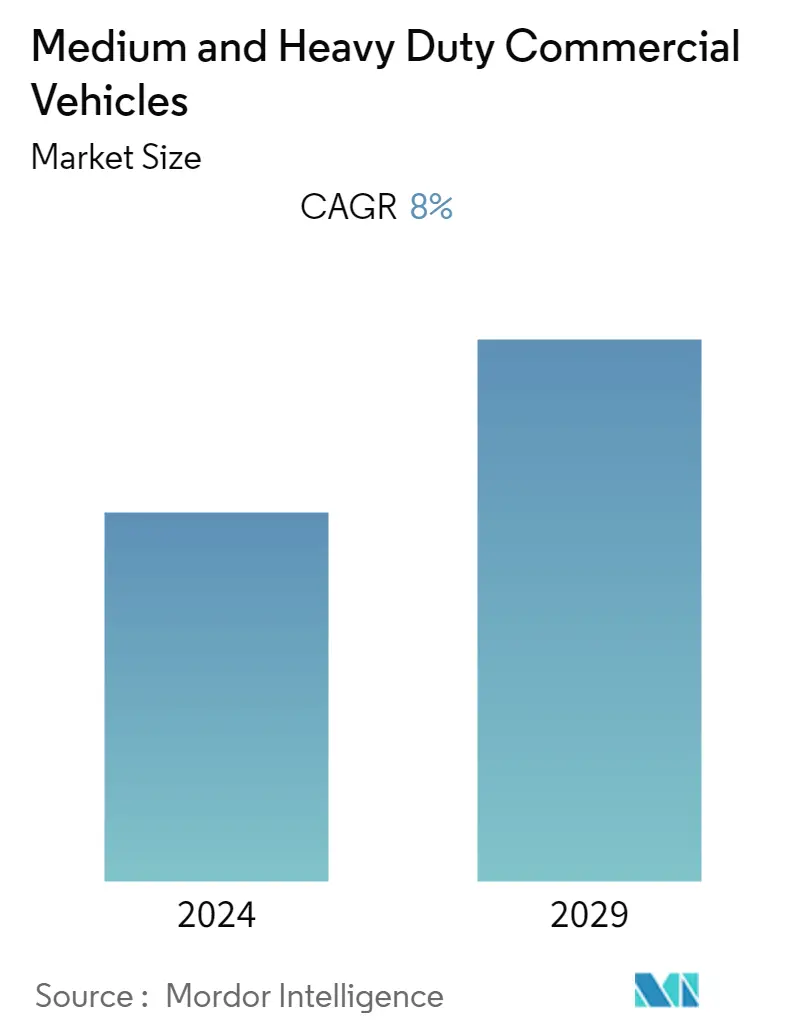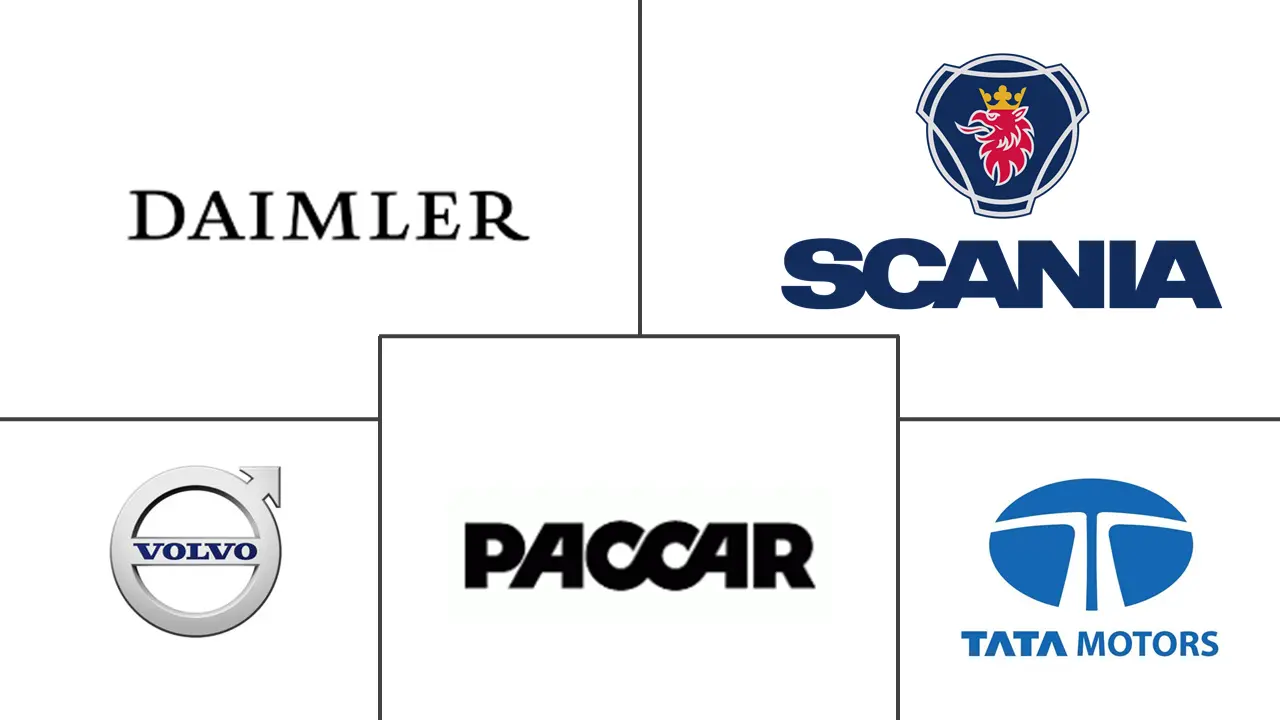Market Size of Medium and Heavy Duty Commercial Vehicles

| Study Period | 2019 - 2029 |
| Base Year For Estimation | 2023 |
| CAGR | 8.00 % |
| Fastest Growing Market | Asia Pacific |
| Largest Market | Asia Pacific |
| Market Concentration | High |
Major Players
*Disclaimer: Major Players sorted in no particular order |
Medium and Heavy Commercial Vehicles Market Analysis
The Medium and Heavy Duty Commercial Vehicles Market was valued at USD 300 billion in 2021 and is expected to grow to USD 480 billion by 2027, registering a CAGR of over 8% during the forecast period (2022 - 2027).
Production was stopped when the world manufacturing units were shut down due to the COVID-19 pandemic. Due to this, the need for transport was completely reduced. Due to disruption in the supply chain, leading truck manufacturers stopped production. But the increased need for transport in the aftermath of the Covid-19 pandemic is a ray of hope for medium and heavy-duty commercial vehicles. With the gradual relaxation of lockdown and restrictions, the medium and heavy-duty commercial vehicles market has a great chance to bounce back from the economic crisis.
Some major factors driving the growth of the market are the expansion of industrial sectors in the emerging market, growing demand from the logistics industry, and rising demand from the construction sector (owing to growing construction activities). The market is expected to witness growth in the coming years due to growing economies across developing and developed counties.
Owing to consistent technological advancements and the enactment of stringent emission norms, automakers (OEMs) are shifting their focus toward electric vehicles. The increasing number of construction and e-commerce activities increased demand for material transportation, resulting in increased sales of commercial vehicles worldwide.
Medium and Heavy Commercial Vehicles Industry Segmentation
The medium and heavy-duty commercial vehicle market has been segmented by Tonnage (3.5 - 7.5 Tons, 7.5 - 16 Tons, and above 16 Tons), Propulsion Type (IC Engine, Plug-In Hybrid, Electric, and Alternative Fuel Powered), and Geography (North America, Europe, Asia-Pacific, and Rest of the World). The report offers market size and forecasts for Medium and Heavy-Duty Commercial Vehicles in terms of volume (units) and value (USD billion) for all the above segments.
| By Tonnage | |
| 3.5 - 7.5 ton | |
| 7.5 - 16 ton | |
| Above 16 ton |
| By Propulsion Type | |
| IC Engine | |
| Plug-In Hybrid Electric | |
| Battery Electric | |
| Alternative Fuel Powered |
| By Geography | |||||||
| |||||||
| |||||||
| |||||||
|
Medium and Heavy Duty Commercial Vehicles Size Summary
The medium and heavy-duty commercial vehicles industry is poised for significant growth, driven by the resurgence in demand for transportation solutions following the disruptions caused by the COVID-19 pandemic. As manufacturing units resume operations and supply chains stabilize, the market is expected to recover and expand, supported by the burgeoning industrial sectors in emerging markets and the increasing demand from logistics and construction industries. Technological advancements and stringent emission norms are steering original equipment manufacturers towards electric vehicles, aligning with global trends towards eco-friendly and cost-effective transportation solutions. The market is further bolstered by collaborations among major players to develop electric trucks, reflecting a strategic shift towards sustainable mobility.
The Asia-Pacific region emerges as a key driver of market growth, fueled by substantial infrastructure investments and ongoing construction projects. Countries like China, Indonesia, and India are making significant financial commitments to enhance their infrastructure, thereby increasing the demand for heavy-duty commercial vehicles. The market landscape is moderately consolidated, with major players such as Daimler AG, Toyota Motor Corporation, and Volvo Group leading the charge. Strategic alliances and acquisitions, such as Isuzu Motors' acquisition of UD Trucks, highlight the dynamic nature of the industry. Government incentives and subsidies, along with improvements in vehicle design, are expected to further propel the adoption of hybrid and electric trucks, creating lucrative opportunities in the logistics, infrastructure, and transportation sectors.
Medium and Heavy Duty Commercial Vehicles Market Size - Table of Contents
-
1. MARKET DYNAMICS
-
1.1 Market Driver
-
1.2 Market Restraint
-
1.3 Industry Attractiveness - Porter's Five Forces Analysis
-
1.3.1 Threat of New Entrants
-
1.3.2 Bargaining Power of Buyers/Consumers
-
1.3.3 Bargaining Power of Suppliers
-
1.3.4 Threat of Substitute Products
-
1.3.5 Intensity of Competitive Rivalry
-
-
-
2. MARKET SEGMENTATION
-
2.1 By Tonnage
-
2.1.1 3.5 - 7.5 ton
-
2.1.2 7.5 - 16 ton
-
2.1.3 Above 16 ton
-
-
2.2 By Propulsion Type
-
2.2.1 IC Engine
-
2.2.2 Plug-In Hybrid Electric
-
2.2.3 Battery Electric
-
2.2.4 Alternative Fuel Powered
-
-
2.3 By Geography
-
2.3.1 North America
-
2.3.1.1 United States
-
2.3.1.2 Canada
-
2.3.1.3 Rest of North America
-
-
2.3.2 Europe
-
2.3.2.1 Germany
-
2.3.2.2 United Kingdom
-
2.3.2.3 France
-
2.3.2.4 Spain
-
2.3.2.5 Rest of Europe
-
-
2.3.3 Asia-Pacific
-
2.3.3.1 China
-
2.3.3.2 Japan
-
2.3.3.3 India
-
2.3.3.4 South Korea
-
2.3.3.5 Rest of Asia-Pacific
-
-
2.3.4 Rest of the World
-
2.3.4.1 Brazil
-
2.3.4.2 South Africa
-
2.3.4.3 Other Countries
-
-
-
Medium and Heavy Duty Commercial Vehicles Market Size FAQs
What is the current Medium and Heavy Duty Commercial Vehicles Market size?
The Medium and Heavy Duty Commercial Vehicles Market is projected to register a CAGR of 8% during the forecast period (2024-2029)
Who are the key players in Medium and Heavy Duty Commercial Vehicles Market?
PACCAR Inc, Daimler AG, Volvo Group, MAN SE and Tata Motors Limited are the major companies operating in the Medium and Heavy Duty Commercial Vehicles Market.

